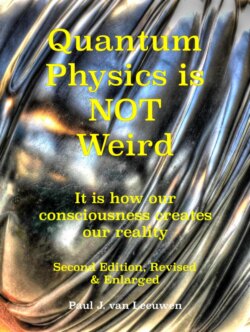Читать книгу Quantum Physics is NOT Weird - Paul J. van Leeuwen - Страница 8
На сайте Литреса книга снята с продажи.
The Ames room, how our brain deceives us
ОглавлениеKnowing already 'how things work' can be an obstacle to perceiving things as they are. Let’s experience the Ames Room illusion.
The image below shows how we are visually deceived by the ‘Ames Room'. Such a room has its dimensions adjusted to such an extent that – from a certain point of view – the objects and people in it seem to be too big or too small. We are being tripped up visually.
Figure 1.1: Ames room.
Source: siz.io
We ‘know’ what a room is. The concept of a room as a rectangular box seems to be a hardwired concept in our brains. So, if people tinker with this box form, they can play tricks on your visual system. Our brain keeps stubbornly telling us 'how it works’, even in spite of better information. Your visual neural network persists in telling you that the woman in figure 1.1 is a dwarf and that the man is a giant. Such an illusion is a visual paradox. On the Internet [1] you can find a lot of examples where your visual cortex is leading you astray.
Now imagine some stubborn person Mr. S who does not want to accept the distorted dimensions of the Ames room. What he sees, he says, is real. This Mr. S then will need a satisfactory explanation for his observation of objects changing their apparent sizes when moving through the room. He might for example, come up with an ‘Ames’ form field hypothesis. A hypothesis which assumes a certain kind of field that, depending on the position of objects in that field, enlarges or reduces its dimensions. This Ames field hypothesis can be formulated easily in such a way that it is predictive despite its wrongness.
Figure 1.2: Ames Room.
Source: commons.wikimedia.org
Assume the Ames form field hypothesis being set up so that depending on the location of objects in the Ames room those objects grow or shrink physically. The stubborn rectangular box room believer, Mr. S, will now be able to predict correctly what will happen to the ball when it is thrown at the person in the – in reality far-away – corner. The ball will shrink physically.
Incidentally, S should also be able to explain with his theory why the two people throwing the ball to each other do seem not to look entirely straight at each other. If you had not noticed this yet, watch this Ames Room animation [2] carefully.
In the following chapter we will see what the "Ames Room" and the Ptolemaic world view with our earth in the centre have in common and how they both should warn us about scientific hypotheses that misrepresent reality, while seeming right because of their apparent success. The Ames Room will prove to be an apt metaphor to help us to rethink the many current interpretations of the quantum phenomena so that we can free ourselves from the physics ‘rectangular-box-room’ view when we start a journey of discovery for a valid and meaningful interpretation of quantum physics. We are going to think ‘out of the box’.
